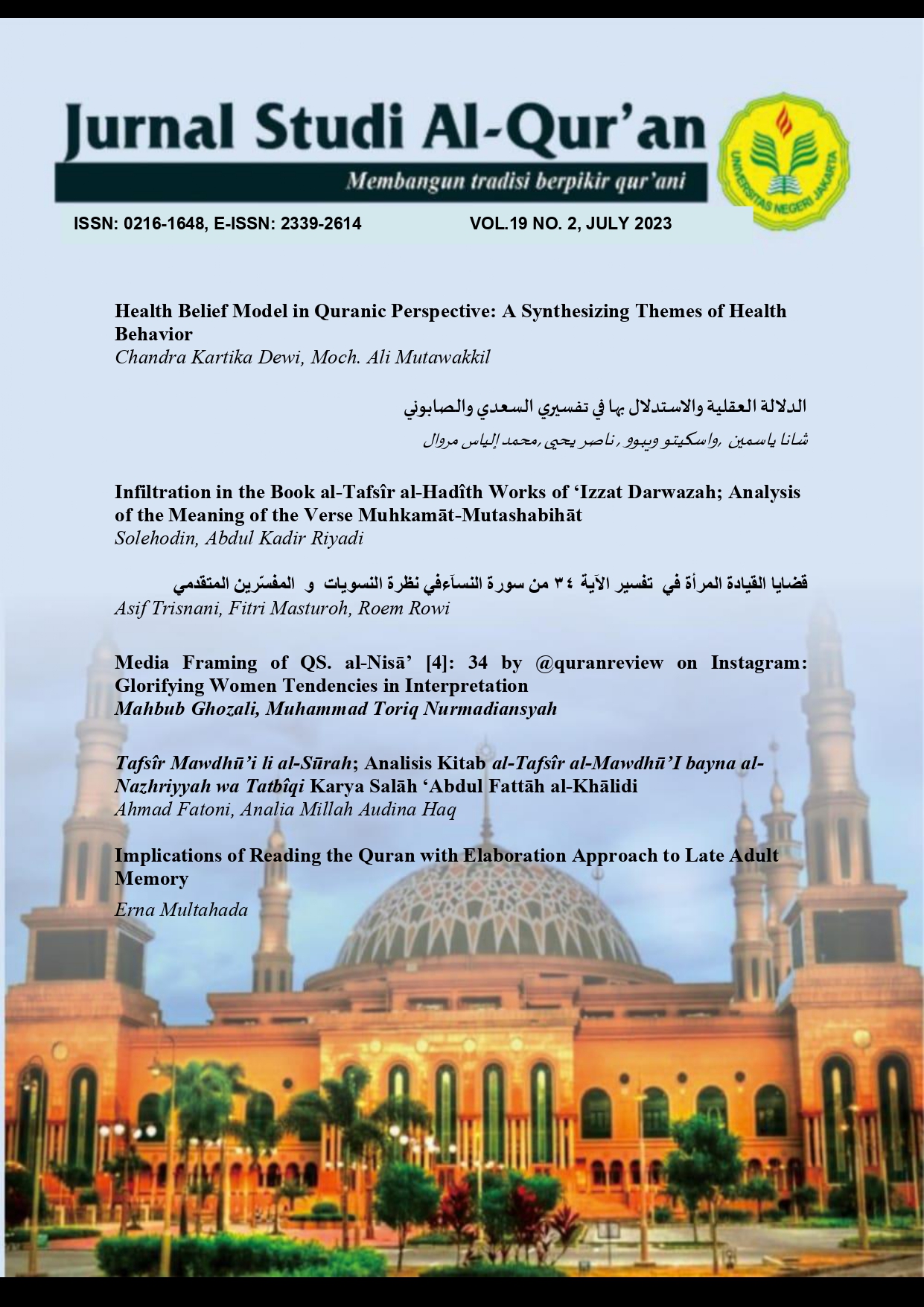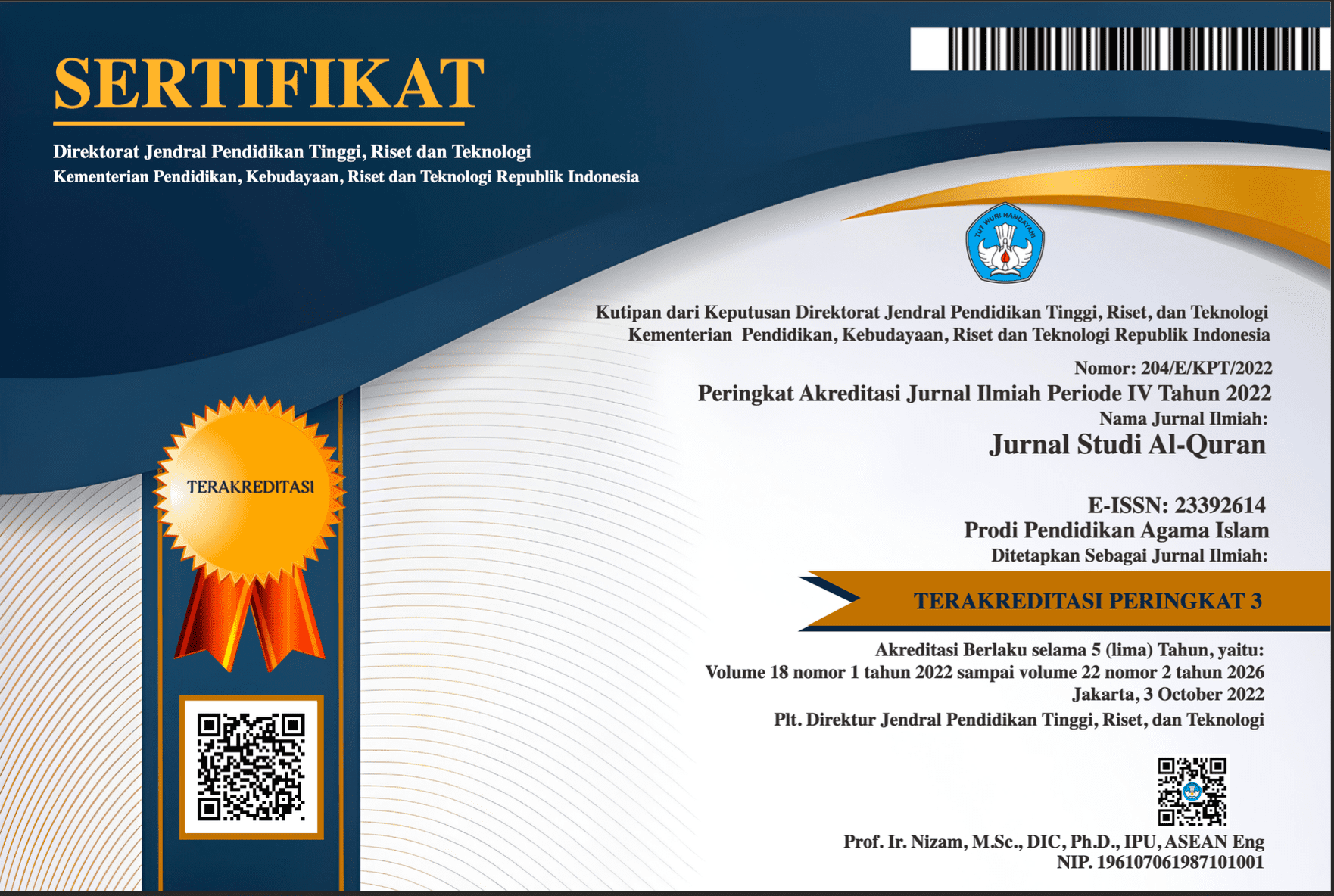Tafsîr Mawdhū’i li al-Sūrah; Analisis Kitab al-Tafsîr al-Mawdhū’I bayna al-Nazhriyyah wa Tatbîqi Karya Salāh ‘Abdul Fattāh al-Khālidi
DOI:
https://doi.org/10.21009/JSQ.019.2.06Keywords:
Tafsîr al-Maudhū'i, al-Khalidi, al-SurahAbstract
The method of interpretation continues to evolve along with the development of interpretation. Contemporary scholars are now more fond of the mawdhū’i method as a systematic method in answering modern problems. Because the mawdhū’i method is a method that discusses a theme in the Koran, both in terms of terms, topics, and surahs in the Koran. One contemporary figure who is concerned with interpreting the mawdhū’i method is Shalah Abdul Fattah al-Khalidi with his commentary work entitled al-Tafsîr al-Mawdhū’i bayna al-Nazhariyyah wa Tathbîqi. So, this research wants to know the interpretation of mawdhū’i li as-Sūrah al-Qur'ani al-Khalidi in his book, and wants to analyze the methods. This research includes qualitative research with the type of library research. In gathering data, researchers referred to primary data, namely the book al-Tafsîr al-Mawdhū’i bayna al-Nazhariyyah wa Tathbîqi supported by secondary sources obtained from supporting literature, such as books, journals, and so on. The data collection technique uses documentation techniques. While data analysis using descriptive analysis method. The findings in this study are: (1) al-Khalidi divides the discussion into two, namely theory (nazhari) and practice (Tathbîqi), and (2) al-Khalidi formulates steps in explaining one sura, including mentioning the names of other surahs, the pronunciation of surah names in the Qur'an, the name of the surah ijtihādy, the time and place of the revelation of the sura, the situation of the revelation of the sura, the main purpose of the sura, the characteristics of the sura, the relationship between the surah Muhammad and the surah before and after the suadah, grouping the suras according to the theme, and explaining the hidden meanings in the suras.
References
Hidayat, A. A., Effendi, M. R., & Hakam, A. (2021, November). Religion and Tradition: Overview of Culture and Islamic Acculturation in The Ciptagelar Society. In Proceeding International Conference on Islam and Civilization (ICONIC) (Vol. 1, No. 1, pp. 223-232).
Khalidi, Shalah} Abdul Fattah (al). Tafsîr al-Mawdhū’ibayna Nazhariyyah wa Tathbîqi. Oman: Dar al-Nafa>is, 2012.
…………………………………….Ma’atih} li Ra’mul Ma’ al-Quran. Bairut. Da>r al-Qalam, 1994.
Syaikh, Muhammad bin Abdullan Ali Amru, Mahmud Yusuf Alu. Us}u>l al-Tarbiyyah al-Islamiyyah. t.tp: KSA. 2008.
Qatta>n, Manna>’ (al). Mabahi>th Fî Ulūm al-Qur’ān. Beirut: al-Risalah, 1402 H..
Tadjudin, A. A. (2020). Corak Pemikiran Hukum Teologi Asy’ariyyah; Studi Pemikiran Hukum Abu Hâmid Al-Ghazâli (450 H-505 H) Dalam Al-Mustashfâ Min ‘Ilm Al-Ushûl. Muttaqien; Indonesian Journal of Multidiciplinary Islamic Studies, 1(1), 1-17.
Thahmāz, ‘Abd al-Hamîd Mahmūd. al-Tafsîr al-Mawd}u>‘i> li Suwar al-Qur’ān al-‘Az}i>m. Juz 1. Damaskus: Da>r al-Qalam. 2014.
Alami, Zaher al-‘Iwad (al). Dira>sat Fî al-Tafsîr al-Mawdhū’ili al-Qur’ān al-Kari>m. Riya>d}. Maktabah Al-Malik Fahad Athna an-Nasyr. 2007.
Asfahani, ar-Ragib (al). Mu’jam Mufrada>t alfa>z} al-Qur’ān. Bairut. Da>r al-Kutub al-Ilmiyah. 1971.
Daghamain, Ziyad Khalil Muhammad (Al). Manhajiyya>t al-Bah}th fi al-Tafsîr al-Mawdhū’i li al-Qur'a>n al-Kari>m. Amman. Da>r al-Basyi>r. 1995.
Baidan, Nashruddin. Metode Penafsiran Al-Qur’an. Yogyakarta. Pustaka Pelajar. 2002.
Zulaiha, Eni. "Tafsir Kontemporer: Metodologi, Paradigma dan Standar Validitasnya." Wawasan: Jurnal Ilmiah Agama dan Sosial Budaya, 2. 1. (2017). https://journal.uinsgd.ac.id/index.php/jw/article/view/780
Rahman dkk. Penciptaan dan Pemeliharaan Alam dalam Perspektif al-Qur’an, (2020).
Rosihon, A. Pengantar Ulum al-Qur’an. t.tp: Pustaka Setia. 2018.
Downloads
Published
How to Cite
Issue
Section
License
Authors who publish with this Journal agree to the following terms:
- Author retain copyright and grant the journal right of first publication with the work simultaneously licensed under a creative commons attribution licensethat allow others to share the work within an acknowledgement of the work’s authorship and initial publication of this journal.
- Authors are able to enter into separate, additional contractual arrangementfor the non-exclusive distribution of the journal’s published version of the work (e.g. acknowledgement of its initial publication in this journal).
- Authors are permitted and encouraged to post their work online(e.g. in institutional repositories or on their websites) prior to and during the submission process, as it can lead to productive exchanges, as well as earlier and greater citation of published works.
Users/public use of this website will be licensed to CC BY










